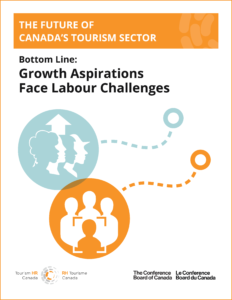Canada’s tourism sector has the potential for significant growth in the coming decades, as both a contributor to the economy and a source of employment for Canadians. However, a key challenge to growing the sector persists in the labour challenges tourism operators face, especially in rural and remote regions.
Tourism HR Canada is pleased to announce the release of the latest update of the Tourism Labour Supply and Demand study, Bottom Line: Growth Aspirations Face Labour Challenges. The study quantifies the implications of long term demographic and economic trends on the supply and demand for labour in Canada’s tourism sector.
Key Findings
- In 2015, the Job Vacancy and Wage Survey showed there were 22,320 vacant full-year jobs in Canada’s tourism sector.
- Spending by tourists and local residents in Canada’s tourism sector could reach $338 Billion by 2035, requiring 2.3 million jobs to meet that demand.
- The past few years have seen an increase in the number of immigrants coming to Canada each year. This policy change has mitigated the number of jobs expected to go unfilled, although it has not eliminated the labour shortfall facing tourism.
- By 2035, the tourism sector could see 93,000 full-year jobs go unfilled, equal to $10.1 billion of potential revenue.

The bottom line is that labour challenges are impeding the growth of the sector. Sixty-three percent of tourism businesses report that labour issues are a key challenge for their business, with problems ranging from difficulty finding qualified staff, local labour shortages, and difficulty retaining reliable employees.
The results show that labour challenges represent a real challenge that reduce the tourism sector’s growth potential. The consequences of labour shortages, such as lack of investor interest in the sector and inability of tourism sector businesses to meet demand, could cost Canada billions of dollars
The outlook may seem bleak, but the projected shortfalls are not inevitable. The projections assume that the attractiveness of tourism occupations, job responsibilities, wages, and access to training and education programs will remain constant. This will not necessarily be the case. Action on the part of governments, the industry as a whole, and individual businesses can significantly increase the number of available tourism workers.
While this report focuses on the future of demand and supply of labour in the tourism sector, it also examines a number of other subjects, including the results of the 2018/19, Tourism Outlook and Labour Issues Survey, potential job openings in tourism, and the effect of the sharing economy on tourism. Look for more information in coming issues of HR Insider.
The full report can be accessed on our emerit.ca website.
National Summary (available free of charge)
[popup_anything id=”6773″]
